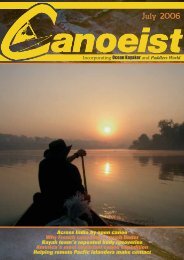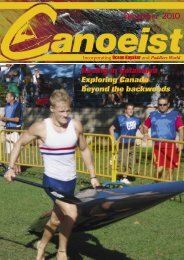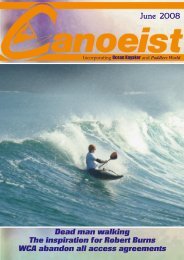November 2006 - Canoeist Magazine
November 2006 - Canoeist Magazine
November 2006 - Canoeist Magazine
You also want an ePaper? Increase the reach of your titles
YUMPU automatically turns print PDFs into web optimized ePapers that Google loves.
Guide Isle of Skye - Southwest Coast<br />
Looking up Loch Brittle past Creag Mhòr towards the Black Cuillins.<br />
remains of crabs suggest it is a feeding area for other<br />
wildlife. Rubh’ an Dùnain has long proved of interest<br />
with a horned chambered cairn underground dwelling<br />
and other cairn and cave activity. A galleried dun was<br />
used by the MacAskills, the Lieutenants of the Coast,<br />
to watch out for storms and for attacks by Clan Ranald<br />
from the Small Isles on behalf of the MacLeods, who<br />
stationed galleys on the landlocked Loch na h-Airde in<br />
order to have them quickly available. The Small Isles<br />
are visible from the Point of Sleat onwards but the<br />
view from here is as good as from anywhere.<br />
Camas a’ Mhûrain is the start of Loch Brittle, where<br />
the intruders from the Small Isles these days are white<br />
tailed sea eagles, larger than the local golden eagles,<br />
which tend to perform their aerobatics when there is<br />
enough wind. Foxes are also present.<br />
The view up the loch is to the Cuillins again. These<br />
offer some of Britain’s best climbing and Glen Brittle is<br />
the main climbing centre on Skye. It is surprising how<br />
many different superlative views there are of the<br />
Cuillins from the water.<br />
Stac an Tuill with Stac a’ Mheadais just visible beyond.<br />
42<br />
The Cuillins again, this time above Loch Eynort.<br />
CANOEIST <strong>November</strong> <strong>2006</strong><br />
Magnificent 150m cliffs, some of the best basaltic<br />
coast cliffs there are, follow to Loch Bracadale with<br />
lava flows and sills so that they look like stratified<br />
rocks. Southerly or southwesterly winds can produce a<br />
lot of swell. Flows are northwestwards from an hour<br />
and twenty minutes after Dover high water and<br />
southeastwards from four hours forty minutes before<br />
Dover high water to 2km/h. The highest point on this<br />
peninsula is 435m An Cruachan. Rubha Theama Sgurr<br />
is the noticeable projection from the cliffs, perhaps as<br />
the result of rockfalls, but the unique feature is Stac an<br />
Tuill, shaped like a handbell but with a hole through<br />
the middle.<br />
Stac a’ Mheadais beyond Loch Eynort.<br />
A cave by Stac a’ Mheadais, one of many on this coast.





